
The Polyporales are an order of about 1800 species of fungi in the division Basidiomycota. The order includes some polypores as well as many corticioid fungi and a few agarics. Many species within the order are saprotrophic, most of them wood-rotters. Some genera, such as Ganoderma and Fomes, contain species that attack living tissues and then continue to degrade the wood of their dead hosts. Those of economic importance include several important pathogens of trees and a few species that cause damage by rotting structural timber. Some of the Polyporales are commercially cultivated and marketed for use as food items or in traditional Chinese medicine.

Polypores are a group of fungi that form large fruiting bodies with pores or tubes on the underside. They are a morphological group of basidiomycetes-like gilled mushrooms and hydnoid fungi, and not all polypores are closely related to each other. Polypores are also called bracket fungi or shelf fungi, and they characteristically produce woody, shelf- or bracket-shaped or occasionally circular fruiting bodies that are called conks.

Lingzhi, Ganoderma sichuanense, also known as reishi or Ganoderma lingzhi is a polypore fungus native to East Asia belonging to the genus Ganoderma.
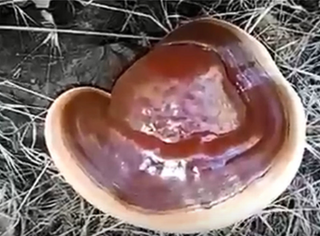
Ganoderma lucidum, commonly known as the reishi, varnished conk, or ling chih, is a red-colored species of Ganoderma with a limited distribution in Europe and parts of China, where it grows on decaying hardwood trees. Wild populations have been found in the United States in California and Utah but were likely introduced anthropogenically and naturalized.

Ganoderma applanatum is a bracket fungus with a cosmopolitan distribution.

Ganoderma is a genus of polypore fungi in the family Ganodermataceae that includes about 80 species, many from tropical regions. They have a high genetic diversity and are used in traditional Asian medicines. Ganoderma can be differentiated from other polypores because they have a double-walled basidiospore. They may be called shelf mushrooms or bracket fungi.

Rhodofomes cajanderi is a widely distributed species of bracket fungus. Commonly known as the rosy conk due to its rose-colored pore surface, it causes a disease called a brown pocket rot in various conifer species. It is inedible. It is widespread in western North America, with more prevalence in southern climates. It has a particular preference for higher-altitude spruce forests.

Laricifomes officinalis, also known as agarikon, eburiko, or the quinine conk, is a wood-decay fungus that causes brown heart rot on conifers native to Europe, Asia, and North America, as well as Morocco. This fungus is the only member of the genus Laricifomes, in the order Polyporales. The fruiting bodies grow in large conks on the trunks of trees.

Ganoderma orbiforme – most commonly known as G. boninense or just Ganoderma in oil palm pathology – is a species of polypore fungus that is widespread across southeast Asia. It is a plant pathogen that causes basal stem rot, a disease of the African oil palm. The fungus was first described scientifically in 1838 by Elias Magnus Fries from collections made in Guinea. Leif Ryvarden transferred it to the genus Ganoderma in 2000. In addition to its type locality, the fungus has also been collected from the Bonin Islands in the Pacific, and from Venezuela and Puerto Rico.
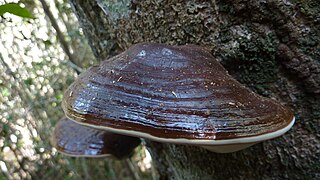
Ganoderma tornatum is a fungal plant pathogen in the genus Ganoderma. It is a species of basidiomycete fungi in the family Polyporaceae. Members are also known as bracket fungi, or polypores.

Daedaleopsis confragosa, commonly known as the thin walled maze polypore or the blushing bracket, is a species of polypore fungus in the family Polyporaceae. A plant pathogen, it causes a white rot of injured hardwoods, especially willows. The fruit bodies are semicircular and tough, have a concentrically zoned brownish upper surface, and measure up to 20 cm (8 in) in diameter. The whitish underside turns gray-brown as the fruit body ages, but bruises pink or red. It is found all year and is common in northern temperate woodlands of eastern North America, Europe, and Asia. The species was first described from Europe in 1791 as a form of Boletus, and has undergone several changes of genus in its taxonomic history. It acquired its current name when Joseph Schröter transferred it to Daedaleopsis in 1888.
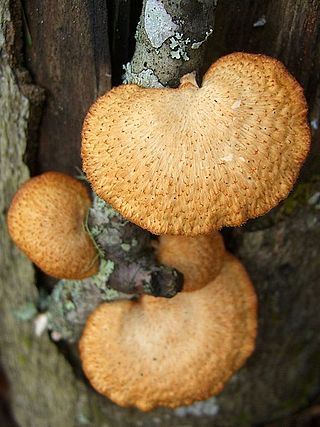
Neofavolus alveolaris, commonly known as the hexagonal-pored polypore, is a species of fungus in the family Polyporaceae. It causes a white rot of dead hardwoods. Found on sticks and decaying logs, its distinguishing features are its yellowish to orange scaly cap, and the hexagonal or diamond-shaped pores. It is widely distributed in North America, and also found in Asia, Australia, and Europe.

Fomes fomentarius is a species of fungal plant pathogen found in Europe, Asia, Africa and North America. The species produces very large polypore fruit bodies which are shaped like a horse's hoof and vary in colour from a silvery grey to almost black, though they are normally brown. It grows on the side of various species of tree, which it infects through broken bark, causing rot. The species typically continues to live on trees long after they have died, changing from a parasite to a decomposer.

Ganoderma curtisii is a wood-decaying polypore whose distribution is primarily in the Southeastern United States. Craig and Levetin claim to have observed it in Oklahoma.

Hapalopilus rutilans is a species of polypore fungus in the family Polyporaceae. Officially described in 1821, it was transferred to its current genus Hapalopilus six decades later. It is commonly known as the tender nesting polypore, purple dye polypore, or the cinnamon bracket. This widely distributed species is found on five continents. It grows on the fallen or standing dead wood of deciduous trees, in which it fruits singly, in groups, fused, or in overlapping clusters. Fruit bodies are in the form of kidney-shaped to semicircular, cinnamon-orange-brown brackets. The underside of the fruit body features a yellowish to brownish pore surface with tiny angular pores, from which spores are released.

Pycnoporellus alboluteus, commonly known as the orange sponge polypore, is a species of polypore fungus in the family Fomitopsidaceae. Distributed throughout the boreal conifer zone, the fungus is found in mountainous regions of western North America, and in Europe. It causes a brown cubical rot of conifer wood, especially spruce, but also fir and poplar. The soft, spongy orange fruit bodies grow spread out on the surface of fallen logs. Mature specimens have tooth-like or jagged pore edges. A snowbank mushroom, P. alboluteus can often be found growing on logs or stumps protruding through melting snow. Although the edibility of the fungus and its usage for human culinary purposes are unknown, several species of beetles use the fungus as a food source.
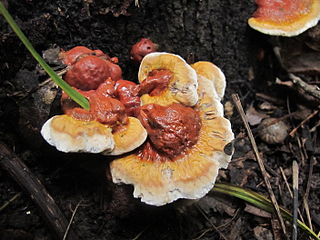
Ganoderma sessile is a species of polypore fungus in the Ganodermataceae family. There is taxonomic uncertainty with this fungus since its circumscription in 1902.

Ganoderma megaloma is a species of bracket fungus in the family Ganodermataceae.

Nigroporus vinosus is a species of poroid fungus in the family Steccherinaceae, and the type species of the genus Nigroporus. Its fruit bodies have brownish caps with tinges of purple or red. The cap underside has a pore surface the same colour as the cap, and minute pores. Nigroporus vinosus has a pantropical distribution. It has been recorded from Africa, North America, Central America, South America, Asia, and Oceania. It is a wood-decay fungus that causes a white rot.
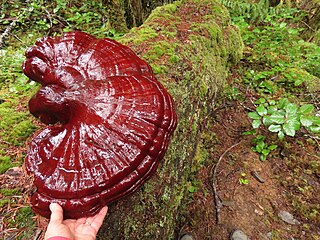
Ganoderma oregonense is a species of bracket fungus that causes root and butt white rot in conifers in northwestern coastal North America, including California, Oregon, Washington, British Columbia, Yukon, and Alaska. G. oregonense is very similar to Ganoderma tsugae, but G. tsugae is associated with east coast Tsuga (hemlock) rather than west coast conifer. Its been speculated that G. oregonense and G. tsugae might actually be one species, but mycologists just don't know for sure yet.





















